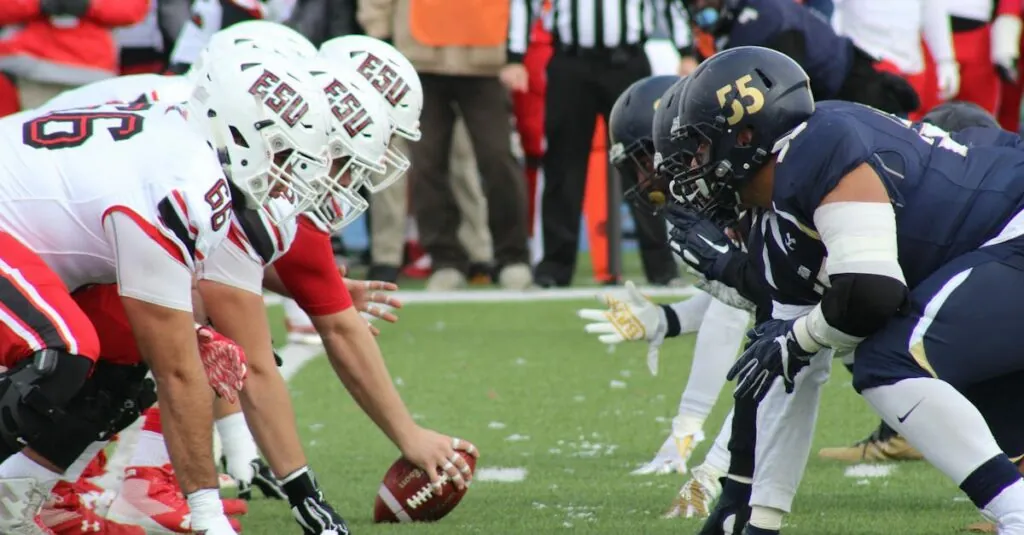Table of Contents
ToggleIn the vibrant world of college football, team logos aren’t just pretty pictures—they’re battle banners that rally fans and intimidate opponents. Each logo tells a story, blending tradition, pride, and a dash of creativity. Whether it’s a fierce mascot or a striking emblem, these logos ignite passion and loyalty, making fans feel like they’re part of something greater than themselves.
Overview of College Football Teams Logos
College football team logos represent various institutions, showcasing their heritage and identity. Each logo incorporates specific elements, often including colors, mascots, and symbols that connect with the school’s history and culture. For instance, the University of Alabama’s logo features an iconic ‘A’ that embodies tradition and excellence.
Designs exhibit a range of styles, from modern and sleek to traditional and intricate. Fans frequently associate these logos with emotional attachment, often feeling pride and loyalty when displaying them. In several cases, teams update logos while retaining core elements, ensuring continuity with their past while appealing to new generations.
Several renowned logos stand out due to their widespread recognition and adherence to continuous improvement. The Michigan Wolverines’ winged helmet logo symbolizes innovation in college football. Likewise, the Notre Dame Fighting Irish logo highlights a fighting leprechaun, encapsulating the spirited nature of the team’s identity.
Logos also play a significant role in branding and marketing strategies. Universities strategically use their logos to enhance merchandise sales, promote school spirit, and create a strong presence during game days. Many fans even collect apparel featuring their favorite teams’ logos, indicating a powerful connection between logos and fan engagement.
Overall, college football team logos serve as visual representations of school pride, embodying the values and traditions each institution upholds. These logos encapsulate the spirit of competition, fostering camaraderie among fans while challenging rival teams.
History of College Football Teams Logos
College football team logos have deep historical roots, reflecting the unique identities of various institutions. These logos carry stories that resonate with fans and celebrate the traditions of college sports.
Early Designs and Their Significance
Early logo designs originated in the late 19th century, often highlighting school colors and mascots. Many early logos aimed to foster school spirit, featuring simple elements easily recognizable. For instance, the University of Michigan adopted its iconic winged helmet in the 1930s, which not only represented the school’s identity but also became a hallmark of college football. Such early designs allowed institutions to cultivate loyalty among supporters and establish a visual connection that persists through generations.
Evolution Through the Decades
As college football gained popularity, logos evolved significantly throughout the decades. The 1960s and 1970s witnessed a trend toward more intricate designs, incorporating modern graphics and typography. Schools like Notre Dame refined their logos, showcasing the Fighting Irish’s leprechaun with a blend of tradition and innovation. The 1990s and 2000s further embraced technology, leading to logos that were dynamic and vibrant. Adaptations often reflected broader cultural shifts, making logos relevant to contemporary fans while still honoring historical significance. This evolution illustrates how logos not only signify a team’s identity but also adapt to the changing landscape of college football culture.
Iconic College Football Teams Logos
College football logos stand out, capturing the essence of teams and their communities. These emblems reflect history, culture, and immense pride among fans.
Analysis of Top Universities
Universities like Alabama, Michigan, and Notre Dame showcase some of the most recognized logos in college football. The University of Alabama emphasizes tradition through its bold ‘A,’ while the University of Michigan displays innovation with its distinct winged helmet. Notre Dame’s leprechaun effectively symbolizes its competitive spirit. Each logo conveys not just identity but also a narrative that resonates with generations of supporters. Logos from these institutions employ specific colors and designs to evoke emotions linked to victory and unity.
Unique Features of Memorable Logos
Memorable logos possess distinguishing characteristics that enhance their appeal. Strong visual elements include vibrant colors, unique mascots, and innovative typography that set teams apart. Simplicity often resonates best; logos maintain clarity across various applications, from merchandise to digital platforms. Recognition plays a crucial role, as fans are quick to identify their beloved teams through these symbols. Adaptability further defines successful logos, allowing them to evolve while retaining core design elements, thus attracting new fans without alienating traditional followers.
The Impact of Logos on Team Identity
Logos play a vital role in defining a college football team’s identity. They encapsulate tradition and foster loyalty among fans.
Branding and Fan Engagement
Logos serve as essential branding tools. Recognizable symbols create a strong connection with supporters, making them feel part of the team. Fans proudly wear merchandise featuring their team logos, boosting overall engagement. Effective logos not only attract attention but also symbolize shared values and community. For instance, the vibrant colors and unique designs of institutions like the University of Alabama promote a sense of belonging. Targeted marketing strategies enhance merchandise sales by leveraging these visual identities, ensuring fans feel connected year-round. Furthermore, engaging social media campaigns featuring logos further solidify the bond between teams and their supporters.
Psychological Effects on Players and Fans
Logos wield significant psychological impact on both players and fans. A well-designed logo instills pride and motivation among players, reminding them of their institution’s history and values. Fans, too, experience emotional highs when displaying their team’s logo. Such connections often translate into heightened support during games. The thrill of seeing a beloved logo can energize the crowd and boost team morale, creating an electrifying atmosphere. Notably, familiar logos like the Michigan Wolverines’ winged helmet spark memories and foster a sense of loyalty among long-time supporters. Through these emotional ties, logos become powerful symbols of team’s identity, uniting communities through shared passion.
College football team logos are vital symbols that encapsulate the spirit and identity of each institution. They go beyond mere graphics to forge emotional connections among fans while representing rich histories and traditions. The evolution of these logos reflects changing cultural landscapes while maintaining core elements that resonate with both new and longstanding supporters.
As these logos continue to adapt and innovate they remain integral to branding and marketing strategies. They not only enhance merchandise appeal but also foster a sense of pride and loyalty among fans. Ultimately college football logos are powerful visual representations that unite communities and celebrate the passion for the game.







